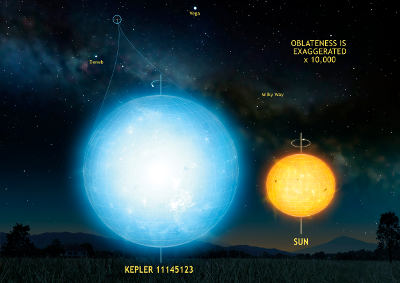The Missing Kingdom: Why Fungi Must Be Central to Conservation Strategy
28 December 2025
Published online 30 November 2016
A new technique allows scientists to measure the shape and structure of moving stars with unprecedented precision.

© Laurent Gizon et al. / Max Planck Institute for Solar System Research / Mark A. Garlick.
This new technique, 10,000 times more precise than its predecessor, reveals a star’s flatter, rounder contours and different rotational speeds. It allows scientists to ‘see’ the nature of the stellar interior with very high precision, according to the scientists.
Traditional techniques can only be used to image some of the largest close-by stars.
Stars are not perfectly spherical. All stars rotate and are therefore flattened by the centrifugal force. The faster the rotation, the more oblate the star becomes. The shape of stars can also be distorted by magnetic fields.
“Stellar magnetic fields, especially weak magnetic fields, are notoriously difficult to directly observe on distant stars,” says lead author Laurent Gizon, researcher at the Max Planck Institute for Solar System Research, Germany.
Gizon’s research focused on the evolution of stars, which is typically controlled by the nuclear reactions at their core.
“Measuring the shape of stars can inform us about their rotation and their magnetic field, two fundamental properties of stars,” he says. Stellar magnetic fields are responsible for active phenomena such as sunspots and flares.
Gizon and his colleagues studied a hybrid pulsating star — hot, luminous, more than twice the size of the Sun and rotates three times slower — called Kepler 11145123. They found that the star, whose oscillations were observed by NASA’s Kepler mission for four years, is less oblate than implied by its rotation rate — meaning that its structural distortion is caused by more than rotation alone.
“This is an indication of the presence of a magnetic field,” says Gizon. “We propose that the presence of a magnetic field at low latitudes could make the star look more spherical to the stellar oscillations.”
Through this new technique, the researchers managed to separate frequencies of the sound waves oscillating from the star’s interior, discovering that the star rotated faster at the surface than at the core.
Of the significance of the discovery, Othman Benomar, researcher at the Center of Space Science at New York University Abu Dhabi, and co-author of the study, says, “stars are elementary components of our universe and it is important to precisely understand the mechanisms of their birth, evolution and death if one wants to understand the evolution of larger structures in the universe such as stellar clusters, and galaxies.”
According to Benomar, until this research, only little has been known about the physical conditions, such as pressure, temperature, nuclear reaction rate, magnetic field or rotation of the interior of stars.
“This is due to two reasons. Firstly, stars are very distant, dense and opaque objects, for which in situ measurements are not possible. Secondly, conditions in the deep interior are so extreme that they cannot be reproduced in laboratories,” he says.
In the future, the scientists plan to map out deformities of more rapidly spinning stars. “It will be particularly interesting to see how faster rotations and a stronger magnetic field can change a star’s shape. An important theoretical field in astrophysics has now become observational,” says Gizon.
Joseph Gelfand, assistant professor of physics at NYUAD who was not involved in the study, describes the research and findings as “exciting” with some caveats.
Indeed, it’s the first time that asteroseismology has been used to measure the magnetic field strength of a star, says Gelfand. But while magnetic fields might be the cause of the discrepancy between oscillations implied by stellar rotation rates and measured, “there are other possibilities, and this technique isn't really able to give the strength of the magnetic field.”
“That being said, the origin and strength of stellar magnetic fields is an important question relevant to a lot of fields of astrophysics and plasma physics — where magnetic fields are often acknowledged to be very important but too complicated to be studied.”
doi:10.1038/nmiddleeast.2016.212
Stay connected: